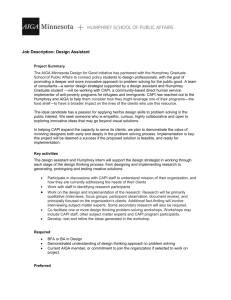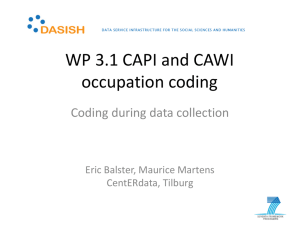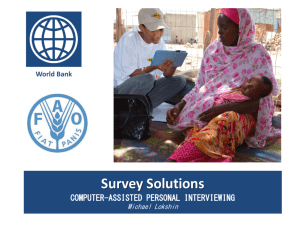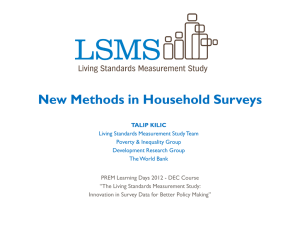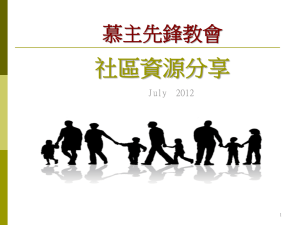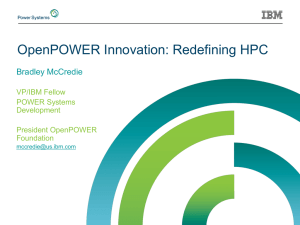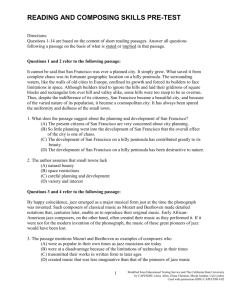LSMS Sample Template
advertisement
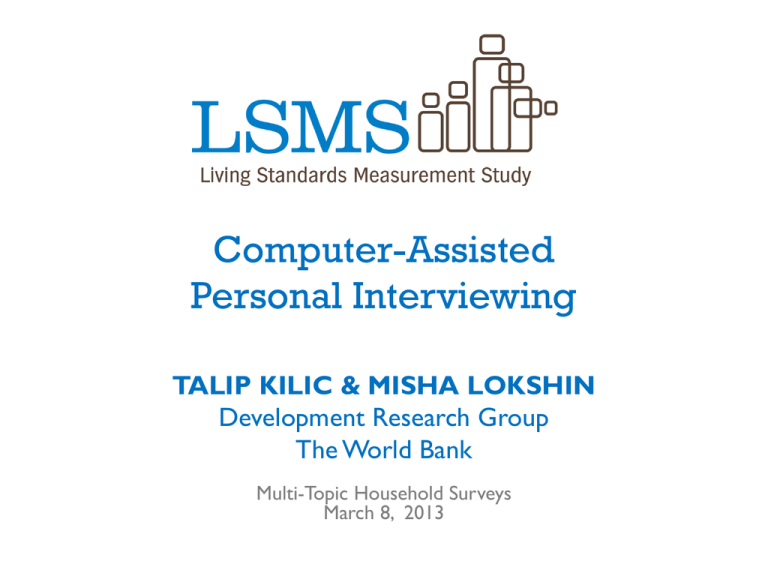
Computer-Assisted Personal Interviewing TALIP KILIC & MISHA LOKSHIN Development Research Group The World Bank Multi-Topic Household Surveys March 8, 2013 Computer-Assisted Personal Interviewing (CAPI) • PAPI: Paper-based personal interviewing, coupled with computer-assisted field-based data entry (CAFE) pioneered by the LSMS • CAPI: Integration of interviewing & data entry through the use of a handheld device, preloaded with an electronic questionnaire • Household (HH) surveys implemented on CAPI platform since the late’ 80’s in high- & middle-income countries, inc. the Netherlands, the UK, the US, Norway & Turkey • Increasing number of applications in low-income setting in recent years – Mobile Phones, PDAs vs. Netbooks & Tablet PCs • Need to balance urgency & quality, to emphasize value of experimentation & research LSMS Experience • LSMS operations marked by a gradual transition to CAPI – 2003 - CAPI survey experiment (~200 households) (Albania) • Application developed in CSProX – 2007- CAPI survey (~500 households) (Ngara District, Tanzania) • Application developed in CWEST – 2010 - Kagera Health and Development Survey (KHDS) (Tanzania) • Application developed in CWEST – Uganda National Panel Survey (UNPS) (2009-2014) • Supported by LSMS-ISA, implemented by Bureau of Statistics • Partial transition to CAPI in 2010/11 (in CWEST); CAPI transition completed in 2011/12 (on-going; in CWEST & Surveybe); Next round 2013/14 – Ethiopia Rural Socioeconomic Survey (ERSS) (2011-2014) • Supported by LSMS-ISA, implemented by Central Statistical Agency • CAPI application developed in Surveybe for the Ag Questionnaire, implemented in a subset of EAs in 2011/12; Next round in 2013/14 Hardware Options General Features: • – Rapid navigation across questionnaire – Several questions displayed at one time Samsung Q1b Ultra (KHDS; UNPS) $650-700 • Camera, microphone, virtual keyboard & hand-writing recognition software • 5-7 hours of (initial) battery life – Extended battery pack, external battery pack & daily charge of batteries recommended – Generators in low-electrification settings Asus Eee PC T101MT (UNPS; ERSS) $450-500 • Google Nexus 10 Tablet $400-600 7-10’’ stylus-/touch-friendly screens Multiple ports: Internet dongles, GPS units, external keyboards Software Options • Traditional DE software designed for transfer from paper questionnaire to computer – Benefits of relying on CAPI better realized working with software packages designed for interactive interviewing • CAPI software packages make up a small market, with varying degrees of cost effectiveness & types of strengths – Key players: Blaise, CASES, CSProX, MMIC & Surveybe • LSMS-commissioned comparative assessment of software programs for the development of CAPI applications (available on www.worldbank.org/lsms-isa) • CAPI Platform development underway in DECCT, in collaboration with the LSMS Why CAPI? • Expected gains in timeliness of data availability – Data entry, checking & exportation in one application • Enhanced tools for in-field/remote management of teams under one roof – Headquarters & Team Leaders: Assigning work, tracking progress, immediate & comprehensive feedback • Expected gains in scope & quality of data – Real time survey experiments/questionnaire randomization – GPS coordinates, time stamps, audio & video recording – Accommodation of non-linear/integrated questionnaires – Automated routing reduces the incidence of missing data – Data checking, reporting & revision facilities during the interview – Range & consistency checks, flags for missing fields – Improvements in quantification of nonstandard units – Instructions on questions, note taking facilities Non-linear Navigation Automated Routing Consistency Checks Consistency Checks (Cont’d) Use of Media for Better Quantification Use of Media for Better Quantification Managing Expectations • Data quality control principles in CAPI set-up no different than surveys based on PAPI with CAFE • CAPI tools useful as much as enumerators & field supervisors take advantage of available facilities & act on inconsistencies • Relative impact of CAPI on data quality: Open question, more experimentation & research necessary – Limited evidence on improved data quality with respect to a wellsupervised survey based on PAPI with CAFE – Fafchamps, M., McKenzie, D., Quinn, S., and Woodruff, C. (2010). Using PDA consistency checks to increase the precision of profits and sales measurement in panels. CSAE Working Paper Series No. 2010-19. – Caeyers, B., Chalmers, N., and De Weerdt, J. (2012). “Improving consumption measurement and other survey data through CAPI: Evidence from a randomized experiment.” Journal of Development Economics, 98, pp. 19–33. Cost Implications • CAPI generates (minimal) savings in printing costs & data entry – Savings increase with the complexity & frequency of survey • Significant up-front costs in programming & hardware procurement – More cost-effective if machines are used in other survey operations – Need to budget for the possibility of hardware failure • Increased need for more pilots ahead of the field work • Transition into CAPI also driven by field work structure – Size of the enumerator corps may be prohibitively large • Gradual transition to CAPI as part of the LSMS operations primarily underlined by demand for increased data quality & availability Uganda National Panel Survey (UNPS) CAPI Experience • Team leaders quick to adapt, instrumental in training & knowledge sharing • Required change in institutional thinking on HH survey: Greater up-front work (& costs) with respect to PAPI with CAFE – Prep of Wave I (PAPI) data uploaded onto Wave II (CAPI) application – Hundreds of intra/inter-module consistency checks, in addition to range & default checks for missing values – Programming of rules on generation of household & individual identifiers for new additions to the sample – Training of UBoS Headquarters staff on case management suite UNPS CAPI Experience (Cont’d) • In-country procurement problems – Lags assoc. with operating within Government systems/unreliable suppliers – US procurement by the LSMS-ISA project: Not straightforward either • Anti-virus software critical to maintaining the hardware integrity • Application glitches even after piloting three times: Need for more intensive testing in comparison to PAPI with CAFE • CAPI application platform based on multiple software packages: CWEST & CSPro (in 2010/11); CWEST & Surveybe (in 2011/12) • Dependence on the CWEST application developer for adjustments • Continued reliance on multiple software packages necessitated by lack of case management features on Surveybe • Timely communication of bugs that might compromise the integrity of incoming data critical: No paper questionnaires to re-enter UNPS CAPI Experience (Cont’d) • Continuing improvements to the CAPI application on a rolling basis throughout the field work • Even with internet dongles, slow internet speeds & lack of service in certain areas – Affects timely headquarters review of data sent from the field – Receipt of application updates by the survey teams not always timely • Regular backup of interview files in the field & at the HQ crucial • Lags associated with Surveybe data export • Still need a paper questionnaire for dissemination purposes: CAPI application dictionary is not more than a linear questionnaire report Comparative Assessment of Software Programs for the Development of CAPI Applications • Initially twofold objective: – Inform internal decision making on the choice of surveys for upcoming surveys planned under the LSMS-ISA project, in Uganda, Ethiopia, and Nigeria – Fill the gap in public knowledge on the relative performance of available software packages for the development of CAPI applications for multi-topic household surveys • Peer-reviewed report, managed by the LSMS team, compiled by the IRIS Center at the University of Maryland, reviewed by software developers prior to release • Available on www.worldbank.org/lsms-isa Comparative Assessment… (Cont’d) Software packages screened as suitable for the development of CAPI applications for multi-topic household surveys & evaluated by the report include: Software Developer Blaise Westat & Statistics Netherlands CASES Computer-Assisted Survey Methods Program at the University of California, Berkeley CSProX Serpro, S. A. Entyware Techneos MMIC RAND Labor and Population Open Data Kit The University of Washington’s Department of Computer Science and Engineering Pendragon Forms Pendragon Software Corporation Surveybe Economic Development Initiatives Comparative Assessment… (Cont’d) • Structure of the report – Brief overview of each software package – Comparative assessment of each software package in 12 areas: Evaluation Areas Programming Data Transfer Questionnaire Development Data Exporting Questionnaire Implementation Support & Documentation Interface for Field Users Hardware & Software Needs Questionnaire Navigation Pricing & Upgrades Case Management Extensibility – Detailed evaluation of each software package, accompanied with full functionality check lists for each evaluation area Comparative Assessment… (Cont’d) • No software package is an unequivocal frontrunner in all evaluation areas • Missing across the landscape: A menu-driven development environment for novice users coupled with a command line for more experienced users, replicating functionality in the menu environment, accommodating customization needs • Positive relationship between quality/scope of documentation & proprietary nature of the software (MMIC, ODK vs. Blaise) • Top contenders: – Surveybe: Ease to use (menu-based development environment) but lacks case management suite & only allows for sequential workflow for questionnaire development – MMIC & Blaise: Powerful & expansive in scope but steep learning curve (command line driven development environment) & high need for technical assistance Where Next? • Sustainability of adoption relies on availability of a user-friendly, yet highly customizable, public solution around which in-country capacity could be built • LSMS and Development Economics Computational Tools (DECCT) Unit of the World Bank supporting the development of a publicly available, closed-source CAPI software platform • Initially informed by LSMS field experience & comparative CAPI software assessment • Core interface components: Designer (for Survey Designers), Survey Manager (for Survey Management at the Headquarters & Team Leaders in the Field) & Client (for Interviewers) • Short demo to follow…
